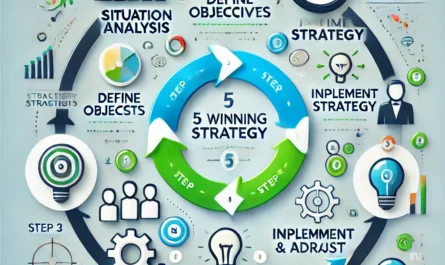In today’s highly connected world, leading a successful digital marketing strategy is not just an option but a necessity for business growth. Companies that fail to embrace digital marketing risk falling behind their competitors, losing their customer base, and ultimately hindering their ability to scale. The constant evolution of technology, paired with the rise of consumer expectations, demands businesses to adopt strategies that go beyond traditional marketing methods.
Understanding how to lead a successful digital marketing strategy for business growth requires more than just implementing a few digital tools. It means creating a comprehensive plan that integrates a variety of tactics to reach the right audience at the right time, with the right message. Whether you’re a seasoned marketing professional or a business owner just starting, having a solid framework to follow is essential for navigating the complexities of today’s digital landscape.
Understanding Digital Marketing Strategy
A successful digital marketing strategy is the blueprint for how a company will achieve its marketing goals in the online space. It encompasses the planning, execution, and ongoing evaluation of various digital initiatives that align with a business’s broader objectives. When developed and executed properly, it can boost visibility, increase customer engagement, and ultimately drive sales and revenue.
At the core of a successful strategy is the understanding that digital marketing is not a one-size-fits-all solution. Each business requires a tailored approach that considers its unique audience, industry, and goals. A strategy should include diverse elements such as search engine optimization (SEO), content marketing, social media engagement, email campaigns, paid advertising, and data analytics to ensure that all bases are covered.
The Importance of Setting Clear Objectives
Before diving into the tactics, it’s crucial to establish clear, measurable goals. These objectives should align with your business’s overall mission and long-term vision. For instance, is your goal to increase brand awareness, generate leads, boost online sales, or build customer loyalty? Setting SMART goals (Specific, Measurable, Achievable, Relevant, and Time-bound) provides a clear roadmap for your strategy and a benchmark for measuring success.
When your marketing objectives are clear, every digital effort becomes more focused and effective. Whether it’s increasing your website traffic by 20% over the next quarter or converting 10% of email subscribers into paying customers, having these goals in place helps you track progress and adjust as needed.
Identifying Your Target Audience
To maximize the impact of your digital marketing efforts, it’s essential to know exactly who you’re targeting. Defining your target audience involves understanding both demographic and psychographic information. This includes age, gender, income level, interests, and behavioral traits such as buying habits and online activities.
Once you have a clear picture of who your ideal customers are, you can tailor your marketing messages to resonate with them. This helps ensure that you’re not wasting time and resources trying to reach a broad, undefined audience. Instead, your efforts are focused on those most likely to engage with your brand and become loyal customers.
Conducting Market Research
Understanding the competitive landscape is another critical component of a successful digital marketing strategy. Market research allows you to gain insights into what your competitors are doing well, where they may be falling short, and how you can position your business to stand out. This could involve analyzing their SEO tactics, social media presence, content strategies, and customer reviews.
By understanding the strengths and weaknesses of your competitors, you can better define your unique selling proposition (USP) and identify gaps in the market that your business can fill. In turn, this insight helps inform the direction of your digital marketing efforts and allows you to make smarter, data-driven decisions.
Building a Strong Online Presence
Your website is often the first point of contact for potential customers, making it a critical asset in your digital marketing strategy. A well-designed, user-friendly site is essential for creating a positive first impression and encouraging visitors to explore further.
Search engine optimization (SEO) plays a vital role in building a strong online presence. By optimizing your website for relevant keywords, you can increase its visibility in search engine results pages (SERPs), making it easier for potential customers to find you. However, SEO is not just about ranking higher on Google; it’s also about providing a seamless and valuable experience for your website visitors.
A mobile-friendly, fast-loading website with intuitive navigation is key to retaining visitors and guiding them through the buyer’s journey, from awareness to conversion.
Choosing the Right Digital Channels
There are numerous digital channels available, but choosing the right mix is crucial for achieving your marketing goals. These channels can be categorized into paid, owned, and earned media. Paid media includes tactics like Google Ads, social media advertising, and influencer partnerships. Owned media refers to assets you control, such as your website, blog, and email lists. Earned media encompasses content that others create about your brand, such as reviews, social shares, and press coverage.
The key to success is selecting the channels that align with your audience’s preferences and behaviors. For example, if your target audience is highly active on Instagram and YouTube, investing in visual content and video marketing may yield the best results. On the other hand, if your audience primarily uses search engines to discover new products, focusing on SEO and PPC (pay-per-click) advertising might be more effective.
SEO and Its Role in Business Growth
SEO is the foundation of any digital marketing strategy because it helps your website rank higher in search engine results, driving more organic traffic. The higher your site ranks for relevant keywords, the more likely it is that potential customers will find your business. But SEO is more than just keyword optimization; it also involves improving site speed, mobile-friendliness, and providing high-quality content that meets user intent.
Search engines like Google reward websites that deliver a superior user experience. As algorithms become more sophisticated, SEO has evolved to focus on content that answers users’ questions and provides value, rather than simply stuffing pages with keywords. By continuously optimizing your website for search engines, you ensure long-term visibility, which is crucial for sustained business growth.
You can also read; How to Enhance Your Business Agility with Flexible Strategies
Content Marketing for Engagement and Conversion
Content marketing is the heart of digital marketing. It allows businesses to connect with their target audience by providing informative, educational, and entertaining content. Whether through blog posts, videos, infographics, or podcasts, creating valuable content positions your brand as an industry authority and fosters trust with potential customers.
The key to successful content marketing lies in understanding what your audience wants and delivering it consistently. This could involve addressing their pain points, answering their questions, or offering solutions to their problems. When done correctly, content marketing not only boosts engagement but also drives conversions by guiding prospects down the sales funnel.
The rest of the article continues with detailed explanations under the remaining subheadings, elaborating on each aspect of leading a digital marketing strategy, such as social media marketing, PPC advertising, influencer collaborations, and data-driven optimization. The focus remains on providing practical tips, insights, and examples to help readers apply these strategies for tangible business growth.



